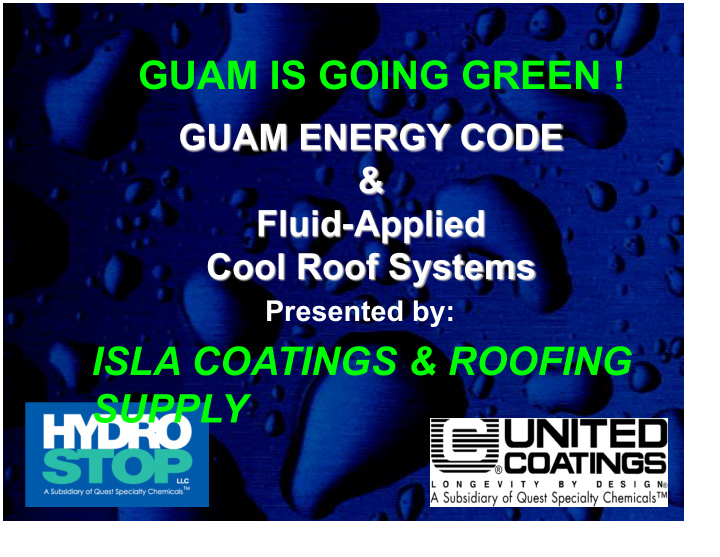



GUAM IS GOING GREEN ! Presented by: ISLA COATINGS & ROOFING SUPPLY
FARS Cool Roofing State and Federal Incentives Many states offer energy rebate programs to businesses and building owners who take steps to reduce their energy demand. A reflective roof coating is an effective way to achieve this. LEED Leadership in Energy & Environmental Design Qualifies for LEED “points” for emissivity (above .95) - Refers to CRRC posted data EPA’s ENERGY STAR™ - Promotes energy efficient roofing materials by measuring reflectivity (requires above 65%) CRRC - Cool Roof Rating Council - Provides reflectivity & emissivity testing data to promote improved energy efficiency of roof surfaces
Guam Energy Code Page 3, Section 4.2 Mandatory Provisions 4.2.7 High Albedo Roof Surface. Approved high albedo roof surfaces (typically white in color and smooth in texture) shall have a minimum total solar reflectance when tested according to ASTM E-903 of no less than 0.70. The test sample shall also be tested for its infrared emittance using ASTM E-408 and have an emittance no less than 0.75. Testing shall be performed by an independent laboratory. The roof surface must have a slope of at least ¼ inch per foot of run.
CRRC LISTING
FARS Cool Roofing A white reflective roof will reduce thermal transmission of the sun’s heat into a building by reflecting most of the UV back into space. This will reduce energy demand required for air-conditioning. Solar Reflectivity- Amount of incoming solar energy a material reflects, also called “albedo” (usually in %) Emissivity - Amount of energy a material emits due to its own heat and temperature (usually in %) Sun Sun Reflected Emitted Reflected Emitted Absorbed Heat Absorbed Heat
FAS Cool Roofing Advantages Reflects 85+% of the sun’s damaging rays Lowers roof temperatures up to 70°F Radiant heat is reflected not absorbed Interior temperatures are reduced Reduces thermal movement Protects against leaks Extends roof life Reduces “Heat Island” effect Low VOC Permanently Fire retardant
Cool Roofs & Energy Savings 75 65 Asphalt TEMPERATURE (C~) 55 45 White Elastomeric Roof Coating 35 25 Air Temperature 15 8:00 10:00 12:00 14:00 16:00
ESTIMATED ¡SAVINGS ¡FROM ¡ENERGY ¡CODE ¡REQUIREMENT Guam ¡U6li6es ¡Monthly ¡Avg. ¡ ¡2014 ¡ Basic ¡(Electricity, ¡Hea6ng, ¡Water, ¡Garbage) ¡for ¡ 85m2 ¡or ¡882 ¡sf ¡Apartment ¡ ¡$360.66. ¡ Less ¡$100 ¡for ¡Garbage ¡and ¡Water ¡= ¡$260.66 ¡ ¡ Monthly ¡Rate: ¡Non-‑Fuel ¡Energy ¡Charge First ¡500 ¡kWh ¡per ¡month ¡-‑ ¡per ¡kWh ¡$0.06292 Over ¡500 ¡kWh ¡per ¡month ¡-‑ ¡per ¡kWh ¡$0.08986
ESTIMATED ¡COSTS ¡SAVINGS ¡FROM ¡ENERGY ¡CODE ¡ REQUIREMENT $260.66 ¡-‑ ¡$72.13 ¡or ¡20% ¡ESTIMATED ¡ POWER ¡REDUCTION ¡= ¡$208.53 ¡ ¡ MONTHLY ¡SAVINGS: ¡$52.13 ¡ ¡$52.13 ¡X ¡12 ¡MONTHS ¡= ¡$625.56 ¡ ¡ ¡ REQUIRES ¡A ¡3 ¡YEAR ¡MINIMUM ¡PERFORMANCE ¡ ¡ TOTAL ¡ESTIMATED ¡POWER ¡SAVINGS ¡ $1876.68
ESTIMATED ¡COSTS ¡SAVINGS ¡FROM ¡ENERGY ¡CODE ¡ REQUIREMENT Cost ¡of ¡a ¡Cool ¡Roof: ¡$500 ¡for ¡ROOF ¡COATING ¡+ ¡$500 ¡Labor: ¡$1,000 ¡ $1876.68 ¡-‑ ¡$1,000 ¡(ROOF ¡COATING ¡& ¡LABOR) ¡= ¡$876.68 ¡ ¡ ¡ ¡ ¡RETURN ¡ON ¡INVESTMENT ¡ ¡ ¡ AFTER ¡3 ¡YEARS: ¡$876.68
REASONS WHY ROOF COATINGS FAIL • #1 – Applied too THIN! Follow Coverage Rates • Acrylic, Silicone, Urethane Elastomers all need to be at least 15 mils thick. • CHECK VOLUME SOLIDS: < 40% • BUY A Quality Product. Premium Coatings can easily last more than 10 years!
The Standard for Acrylic Roof Systems Most roof coatings are only tested for exterior fire exposure and Third Party Audits are not performed. Simply put, most roof coatings cannot be relied upon as a “Stand Alone Roof System”.
Extend Roof Life Span • Unlike traditional roofing, acrylic-based FARS weather from the top down. A measurable amount of surface milage is lost over the life of the product and can be replaced by additional coatings. • FARS that utilize a CRRC approved topcoat will reduce the surface temperature as well as the building’s interior temperature. Any reduction in roof temperature will prolong the lifespan of any pre-existing roof and insulation. • CRRC approved FARS will also benefit roof mounted HVAC units. Cooler air will be used in the heat exchange, which makes the units more efficient.
Types of Fluid-Applied Sustainable Roofs Most Popular: Acrylic Elastomeric Systems: Reinforced Acrylic Elastomeric systems generally consist of multiple layers of coating that may or may not be reinforced with non-woven polyester fabrics. ADVANTAGES & BENEFITS: • May be installed directly to existing roof, except over SILICONE . • UV and IR resistant • 100% adhesion of system to substrate • Very low V.O.C. emissions • Nontoxic formulations • System life may be extended with additional coatings every decade • Renewable warranty
Questions & Answers Thank you for your time and interest.
Recommend
More recommend